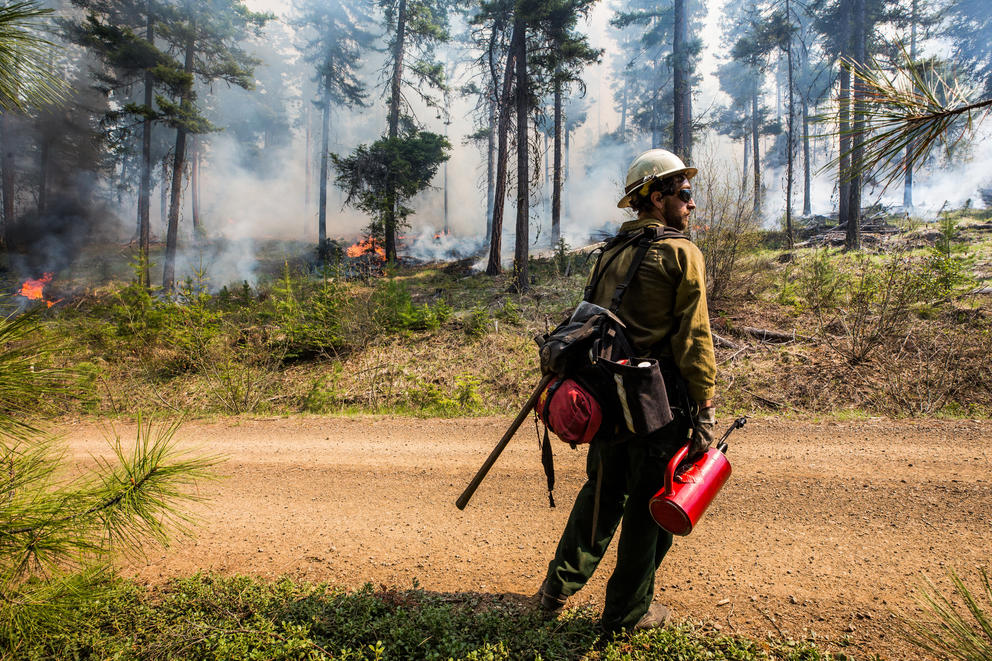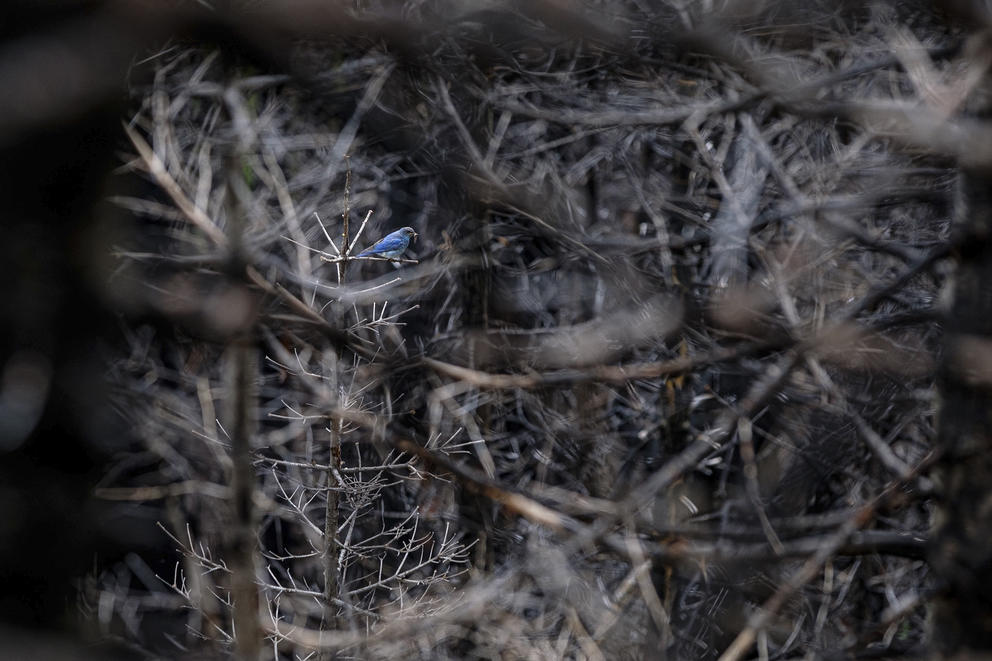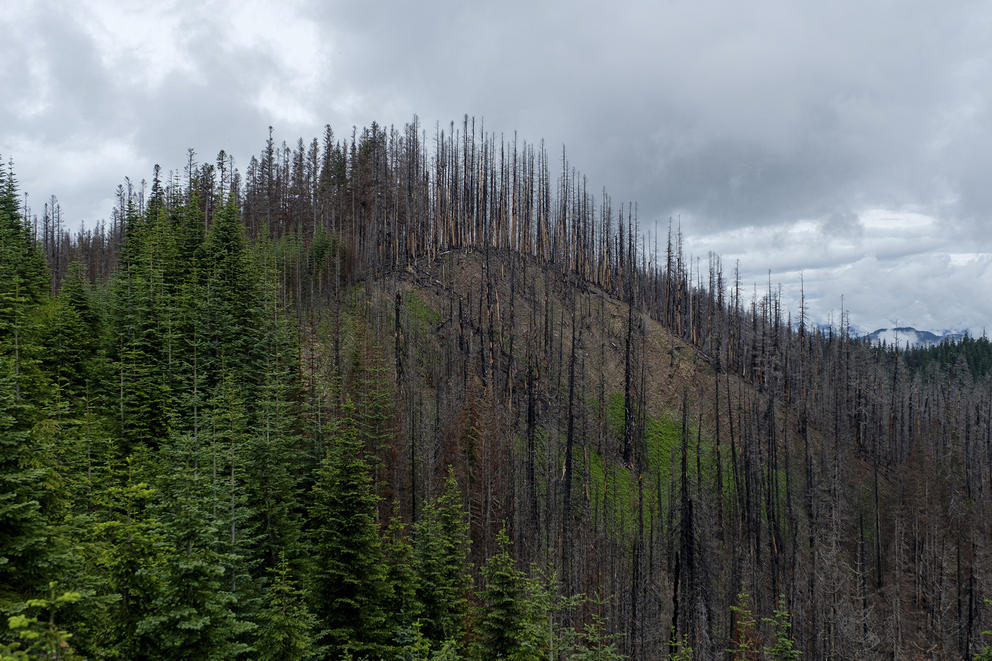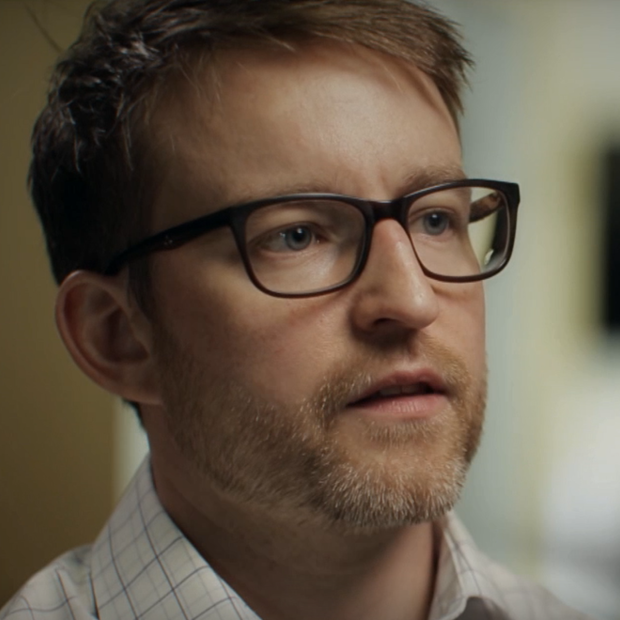The push, led by Commissioner of Public Lands Hilary Franz, would see the state hire 100 firefighters and replace antique firefighting equipment. A forest restoration workforce paid to make Washington’s state and some federal lands less combustible would be created almost from scratch, and communities in fire-prone areas — most of Eastern Washington — would be better protected from fire.
InvestigateWest is a Seattle-based nonprofit newsroom producing journalism for the common good. Learn more and sign up to receive alerts about future stories at bit.ly/invw-newsletter
To its supporters, the money represents a consequential step toward combating the fires that have been consuming huge swaths of the state. Since 2015, 4,843 square miles of Washington have burned, an area the size of Connecticut that accounts for nearly 7% of Washington’s total land mass. That toll is only expected to grow as climate change shrinks snowpack and delivers hotter, longer summers.
While she stressed that it will take years to change the nature of wildfire in Washington, Franz said the money will “change the trajectory” of the state’s fire fight.
“Relying on luck and hope during fire season has turned our wildfire problem into a crisis,” Franz said by email. “This is absolutely a turning point in our fight to protect Washington’s communities and natural resources from smoke and flames.”
Washington’s fire history can be reduced to numbers and dates, figures Rep. Larry Springer, D-Kirkland, recited for the House in early March. In the 1990s, about 134 square miles of the state burned on average each year. By the 2000s, that number rose to 295 square miles. During the past five years, it stood at 763 square miles.
In the statehouse, though, the story of Washington summers of flame and smoke came through in snapshots offered by senators and representatives. Front of mind were the death of 1-year-old Uriel Hyland, a Renton boy killed as his parents fled a central Washington fire in August, and the destruction of Malden, a town of 300 burned in a September firestorm south of Spokane.
Eastern Washington lawmakers also spoke to the smaller pains of life now shaped by fire.
Rep. Alex Ybarra, R-Quincy, described flakes of ash wafting in the air like it had after Mount St. Helens erupted. Rep. Marcus Riccelli, D-Spokane, spoke of the summer youth soccer practices canceled because of the smoke. With hundreds of homes lost to fires, said Rep. Joel Kretz, R-Wauconda, Okanogan and Ferry counties now face a “homelessness crisis.”
“When you lose the number of homes we’ve lost in a tight market, it takes a long time to replace them,” said Kretz, who joined Springer in sponsoring the bill. “We’ve still got people living in camp trailers who lost homes two years ago.”
‘Wildfire is here to stay’
Washington’s bigger burns are the result of two environmental debts coming due — climate change driven by humanity’s greenhouse gas emissions, and mismanagement of the forests and scrubland in the state. While the legislation acknowledges the former, it addresses the latter.
Following the U.S. Forest Service’s lead, land managers spent most of the 20th century extinguishing as many wildfires as they could, as fast as they could. Aggressive firefighting has left forests across the western United States primed for “megafires” like those that devoured 1,600 square miles of Washington timberland in 2015, creating an ash-gray moonscape. On the dry slopes east of the Cascades, brush, branches and dead trees that would’ve burned under natural conditions, clearing out the underbrush and some trees, are now packed too tightly for trees to stay healthy.
A 20-year plan put forward by the Department of Natural Resources estimated that about 1,950 square miles of Washington forest need intervention to be brought back to health. While much of that is managed by the U.S. Forest Service, the legislation would expand the state’s ability to help revive federal land.
Large as it is, the infusion of funding won’t clear Washington’s summer skies or stop the fires from burning. But it is an important step toward limiting the human and ecological damage they cause, said Rachel Baker, forest program director for the Washington Environmental Council.
The aim isn’t to stop all fires everywhere, Baker said. A century of doing so is part of the reason Washington forests are burning so intensely now; forests, particularly those in dry climates like Eastern Washington, are healthiest when they regularly see low-intensity fires that clear the forest floor and destroy the combustible materials that fuel catastrophic blazes.
“The reality is that wildfires are going to be an ongoing challenge we face because of climate change,” Baker said. “Wildfire is here to stay.”
That is not to say, Baker continued, that wildfire can’t be made less damaging by healing Washington’s forests.
Removing the excess fuel that has built up will make forests less likely to burn to ash when fire does arrive; larger trees will weather the low fires, as they have for millennia.
For decades, money meant to go to prevent fires by improving forests has been shifted by necessity to firefighting. Going forward, Washington would build up a robust workforce trained to clear underbrush and thin forests either by hand or through controlled burns, a practice used only sparingly in Washington and most Western states.
While the funding hike directed toward forest restoration is only half of that going to firefighting, that $17 million-a-year boost represents a dramatic shift in the state.
The legislation would enable Washington to set up programs at Washington State University and elsewhere to train a forest restoration workforce. Students would learn to remove underbrush and snags while thinning stands where trees grow too densely. Some would also be certified to use controlled fire to clear out the forests, a technique that is often more efficient and can, if conditions are correct, restore much larger swaths of forest.
At present, the forestry industry lacks trained workers to meet the demands ahead, said Jason Callahan of the Washington Forest Protection Association, a trade group representing private owners of forestland.
“If there’s no one to do the work, it won’t get done,” Callahan told the Senate Ways and Means Committee.
“Labor shortages are a real thing in the forest products industry,” he continued. “These are skilled, green jobs that pay well above the average wages in rural communities.”
Unprecedented investment
Most of the money, though, will go toward firefighting, which would receive 56% of the new funding. Protection is a pressing concern, as about 951,000 homes in Washington sit near forests threatened by wildfire.
The most endangered communities lie in a swath extending from Spokane southwest to the Columbia River, and then running north past Wenatchee into the Methow Valley. Much of Central and Eastern Washington, in other words, where summer fires have become a constant.
“Fire season is unfortunately becoming the fifth season,” Paul Jewell, a lobbyist for the Washington State Association of Counties, told the Senate Ways and Means Committee. During the same hearing, Laura Osiadacz, a Kittitas County Commissioner and volunteer firefighter, described fire as “literally an annual event” on the east side of the Cascades.
Washington state firefighters rely on Cold War-vintage surplus equipment, making fast and decisive firefighting difficult. As envisioned in the legislation, $35 million a year will be spent to build up the state’s wildland firefighting force by more than 100 firefighters — and 20 bulldozers — and bring it into the 21st century.
The bill would see the Department of Natural Resources’ fleet of Vietnam War-vintage helicopters upgraded — two of the Hueys would be set up, for the first time, to fight fire at night — and reinforced by new fixed-wing aircraft. One of the planes, a Pilatus PC-12, would fly high-speed detection missions searching for fires with infrared sensors. The expansion is expected to cost $14 million in 2023, and then about $3.3 million a year going forward.
Another $1.25 million a year would pay for a camera system to replace the fire lookouts that generations ago spent the summers living atop dozens of Washington peaks. The lookout system has been dismantled over the past 25 years without replacement. Under the bill, the Department of Natural Resources would place cameras on mountaintops to watch state lands prone to lightning strikes and human-caused fires.
Those investments aren’t a signal that Washington is poised to return to putting out all fires everywhere, the strategy that landed the state and much of the West in its current predicament, said Baker of the Washington Environmental Council. The aim, she said, is to effectively fight the fires that must be fought while shaping the forests and communities near them to thrive with fire.
“A couple decades down the line, I would hope to see fires on the landscape that aren’t affecting people and are in keeping with the character of the ecosystems,” Baker said.
Thanks to the legislation, crews made up of inmates from state prisons would also, for the first time, be paid more than a pittance for their time on the fire lines. Department of Corrections-staffed crews, which amount to 330 firefighters, would be paid at least minimum wage for their work.
Beyond that, the Department of Natural Resources is expected to create a firefighting crew comprised of people who learned the trade while incarcerated. The 20-person crew would work year-round rehabbing state forests and conducting controlled burns between fire seasons.
Unity in Olympia, at least for a moment
Addressing the House on March 9, Springer told his colleagues that waiting for Mother Nature to deliver deeper snows or wetter summers was “delusion.” A plan is needed, he argued, and the one Franz brought forward is it.
While legislators dickered over aspects of the bill, not one ultimately voted against it.
In a legislative session that has seen the Republican minority complain helplessly as Democrats acted on nearly all of their environment-related priorities, the fire bill was exceptional. Sen. Keith Wagoner, R-Sedro-Woolley, described the bill as the most important piece of legislation to pass through the Legislature this session other than the pandemic relief package.
Legislative Republicans loudly praised the Department of Natural Resources — which often serves as a foil for the GOP, and timberland Democrats — and its chief, Franz, a Democrat who held leadership roles in several environmental advocacy organizations before being elected as Public Lands Commissioner in 2016.
“Commissioner Franz has done an exceptional job of bringing a huge amount of energy and enthusiasm to her position, and, frankly, I believe she’s transformed her agency,” Sen. Brad Hawkins, R-East Wenatchee, said on the Senate floor.
Franz or her successors will have to draw on that goodwill deeply in the years ahead. Even those celebrating the landmark investment in firefighting and prevention acknowledge that it is a start, not a solution.
"This is an all-hands-on-deck moment,” Franz said, “and we will rise or fall together.”
Corrects the name of the Washington Environmental Council.





